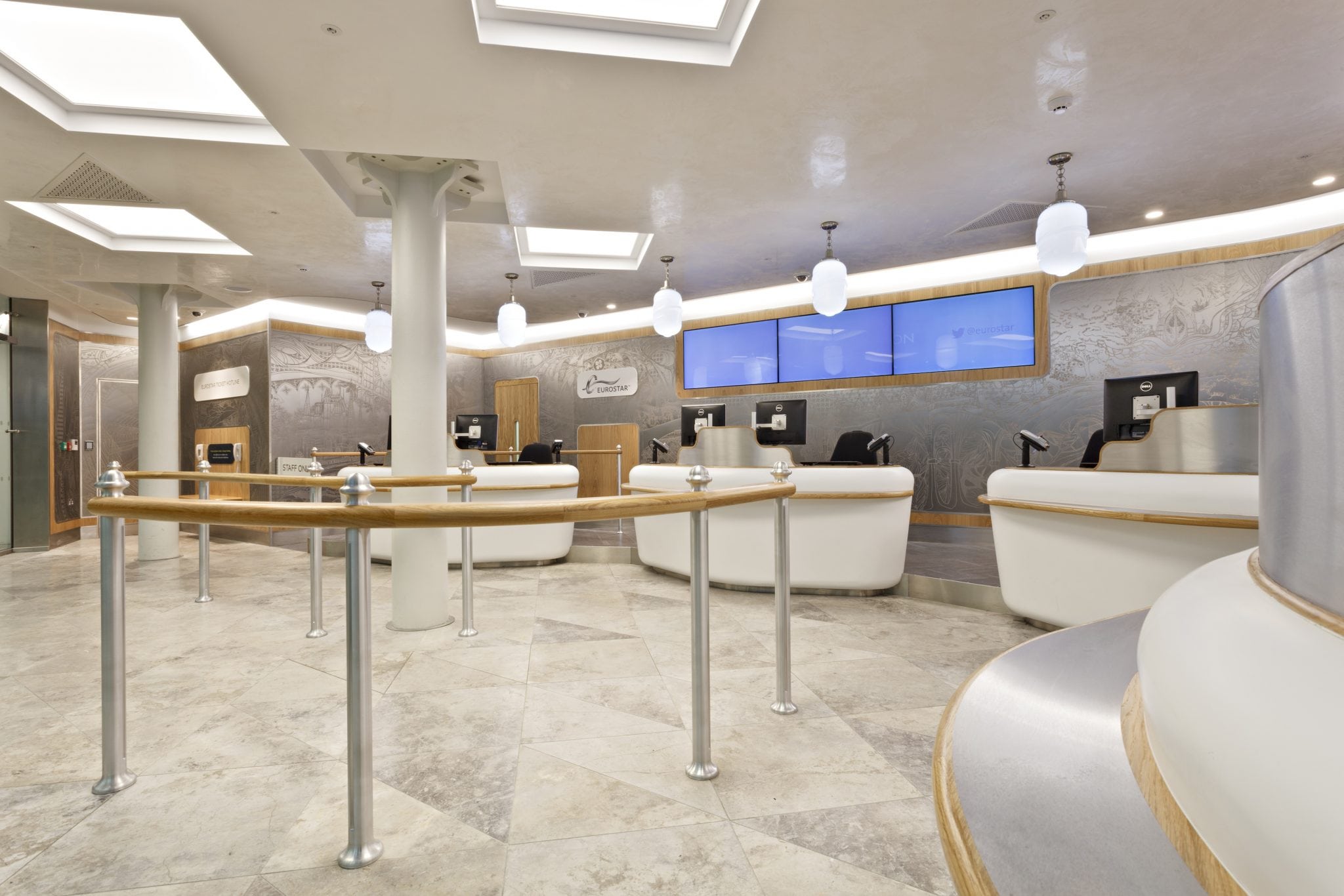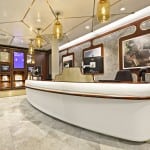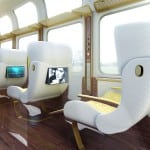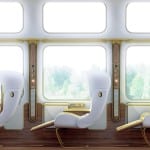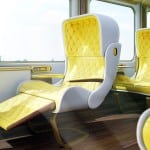Skift Take
A project as visionary as Eurostar deserves this level of lofty design thinking, and it's clear Jenner is comfortable traveling through the ages to find the right elements for his work.
- Eurostar ticket hall at London St. Pancras.
- Eurostar Terminal at London St. Pancras.
- Eurostar lounge at London St. Pancras.
- Eurostar Ticket Hall at London St. Pancras.
- Design concepts for Eurostar Seats.
- Design concepts for Eurostar Seats.
- Design concepts for Eurostar Seats.
Christopher Jenner has taken on the challenge of bringing new elegance and a unique design language to Eurostar, with its new Ticket Hall at St Pancras International in London.
He spoke to Skift about his inspiration for this project, his design philosophy, his own passion for Eurostar, and his vision of how the travel experience could be enhanced for other forms of transport and travel.
If you weren’t around to see the two drills meet at the centre of “The Chunnel” in 1990, it may be hard to understand the strong emotions this longed-for accomplishment produced for those who marveled at the success of what is one of the more ambitious feats of engineering in human history. Joining England to France—and therefore the European continent—overcame historic enmity between the two cultures (if often more teasing cousins than anything else); is an icon for the ambition of a united Europe; and provides travelers on both sides of the tunnel a fast connection between London and Paris that doesn’t require flight.
According to Eurotunnel, the vision behind the project dates back to 1802, when French engineer Albert Mathieu proposed building an underground highway so that horse-drawn carriages could take people across. He proposed a convenient island at the middle so carriage drivers could change horses. A train is a far better alternative.
Speaking to Jenner is intoxicating. He imbues his words with a dreamlike fancy, and helps you see the potential for all things beautiful—untapped in many more functional design approaches or the chilly modern minimalism so often in vogue. Jenner comes from another time, another place; neither past, nor present—nor future. Jenner’s world is timeless, a sweet melange of eras and styles. He gives you a sense that you are speaking more to a romantic time traveller than a man working very much in the now—on very practical and useful applications for design. But we shouldn’t be fooled. Jenner is that too. Between his inspiring words, and well-spun allusions to La Belle Epoque and the Victorian Era, is the reality of a man who knows how to apply his design philosophy optimally.
If we sound as though we are in love what Jenner has realized in the St. Pancras Eurostar Ticket Hall, it’s because we are. If we appear to be smitten with the designer’s language, it was inevitable—the language is so very unique. And to see that language applied to Eurostar is like 100 Christmases at once for observers of transport design trends.
Enough gushing—it’s getting embarrassing. Here’s the interview. Decide for yourselves.
Skift: What were your design objectives for Eurostar for creating an emotive brand experience for passengers?
Jenner: Throughout the design process, we wanted to amplify the spirit of connection. To do this, we needed to find unifying values from which one can devise a strategy and in turn a design process. This approach delivers design which is connective and relatable.
Crucially, for a design experience to work in the transport sector, it needs to be fundamentally responsive and functional. Adding a layer of narrative gives the design an emotional connection. We created a 30 meter stainless steel etching in the Standard class section which follows the journey from London to Europe.
Skift: What were the challenges you encountered for pushing these design concepts through? Were there any special technical limitations you had to overcome?
Jenner: St Pancras International is a listed building with a host of heritage constraints. It was key the design made a contribution to the fabric of the station and remained respectful of it’s history. Our design process is very focused on the design of spaces which fit within their environment. We spend substantial time on cultural research to ensure we capture the provenance of a place.
Designing practical solutions to a brand’s staffing needs is a major part of the design effort. Finding the middle ground to this most essential and necessary deliverable is an exhaustive but key part of a successful proposal.
Skift: How did you want to differentiate Eurostar from other rail service in Europe? Around the world?
Jenner: Eurostar is unique in that it exists out of two of the world’s great cultures. This dual personality lends a special provenance, and an immediate differentiation. This two culture dynamic is a designers gift. It really opens up the points of reference; endless iconic moments and cultural influencers can be utilized throughout a brand.
Skift: What target passenger profile did you have in mind when developing these designs?
Jenner: A travel brand needs to embody a democratic profile. The modern world is incredibly mobile. One needs to consider differences in culture, age and purpose. Essentially, we wanted to design a space which was primarily accessible and responsive.
Skift: In Europe particularly, rail travel competes heavily with air travel. Did you consider the advances made at certain airports and airport lounges, as well as aircraft cabins when developing the design for Eurostar? Where you inspired by the developments on other modes of transport? How do you hope your designs will help Eurostar attract more passengers to cross over by rail rather than taking a plane?
Jenner: I can only respond based on my experiences of traveling between European cities. If you’re based in London, Paris or Brussels there is absolutely no better way to travel between these cities than by rail. I imagine the success of the Eurostar brand and other intercity brands are testament to this.
Where distances are short enough to warrant the move out of air transport, one cannot beat the train. The experience seems on more of a human scale and more exciting; an opportunity to lend a more curated, hospitality driven experience—and you cant beat the view.
Skift: What are the challenges designers must overcome to bring a future-vision of luxury and elegance into the travel and transport sectors?
Jenner: When we set off on a relationship with a new brand we spend substantial time developing and defining a comprehensive design strategy. It’s crucial for a brand to define themselves before they journey down the design path.
The transport industry has a huge spectrum of variables which need to be considered as part of any design process. The key is to develop a project in-line with the expectations of all the stakeholders. There exists huge potential to bring a more crafted , human experience to the industry. It’s the aspect which will define those brands into the future.
Skift: For transport and travel in general, where do you believe the untapped opportunities for passenger experience enhancement lie?
Jenner: The industry is fast moving towards consolidation via global transport hubs, Dubai, Abu Dhabi and Doha are examples of this continuing trend. These ‘stopovers’ offer a brands a captured market, an opportunity to really capitalize on their strategy, to really effect travelers with their values.
Business class lounges particularly lack design and consideration. They are the victims of the global hub success. Where they were once considered, they now lack hospitality, their premium status swapped in favor of the unremarkable. Brands can win huge loyalties from investment in the spaces between the key touch points.
Skift: How did your own passenger experience on the Eurostar help you identify the areas for improvement in the current product?
Jenner: I travel on Eurostar often—many of our clients are based in Paris. It’s a pleasure to travel in—a 20 minute cab ride from our studio.
Whether traveling with the Eurostar or with Etihad, or Singapore Airlines, I am always looking for the same level of care and hospitality. Efficiency and welcome on arrival, moving through the system and speed of departure are all essential building blocks to a memorable and loyalty building service. The start of the journey begins at the purchase of the ticket and so it was important to set the right tone for one’s travel adventure. Any design proposal needs to factor these central principles.
Skift: Tell us about your design proposals for the train cabins themselves, they’re very unique and eye-catching.
Jenner: It’s important to mention that the train interior is simply a conceptual proposal, a “flight of fancy” which will never be realized. It’s not part of my brief for Eurostar. But, I was inspired by Victorian carriages, and the ideal of bringing back that more emotional hand-crafted quality.
Skift: It struck us as a hybrid, with the carriage aspect at the front, but a very modern pod design at the back, with the large embedded screens. In that respect, similar to attractive designs we’ve seen introduced for aircraft seating.
Jenner: It was informed in the present by the past. It’s all about the narrative story-telling when creating a space and a product. For Eurostar, it’s about heralding a return to the Golden Age of travel.
Skift: Would you mind if we point out that it has a certain Steampunk vibe as well?
Jenner: I’ve heard that before. Frankly, I had to look up Steampunk. But yes, the Victorian Gothic is there, it’s a core element of my design, along with Art Nouveau. I suppose it fits.
Skift: Can we talk about your green airport terminal concept?
Jenner: It’s organic. Some terminal designs have become pedestrian. I wanted to propose a space which swapped the unremarkable for the remarkable. Travel arrivals halls should inspire a sense of wonder.
Skift: What other projects would you most like to tackle next?
Jenner: Alongside our recent move into product design, we would like to expand on our experience in the travel sector. Arrivals halls and Hotels seem to be the obvious choice; there’s immense room for improvement in both of these sectors. There’s a fantastic opportunity for creativity with the new airport cities as retail hubs.
The Daily Newsletter
Our daily coverage of the global travel industry. Written by editors and analysts from across Skift’s brands.
Have a confidential tip for Skift? Get in touch
Photo credit: Eurostar Ticket Hall at London St. Pancras. Michael Franke
